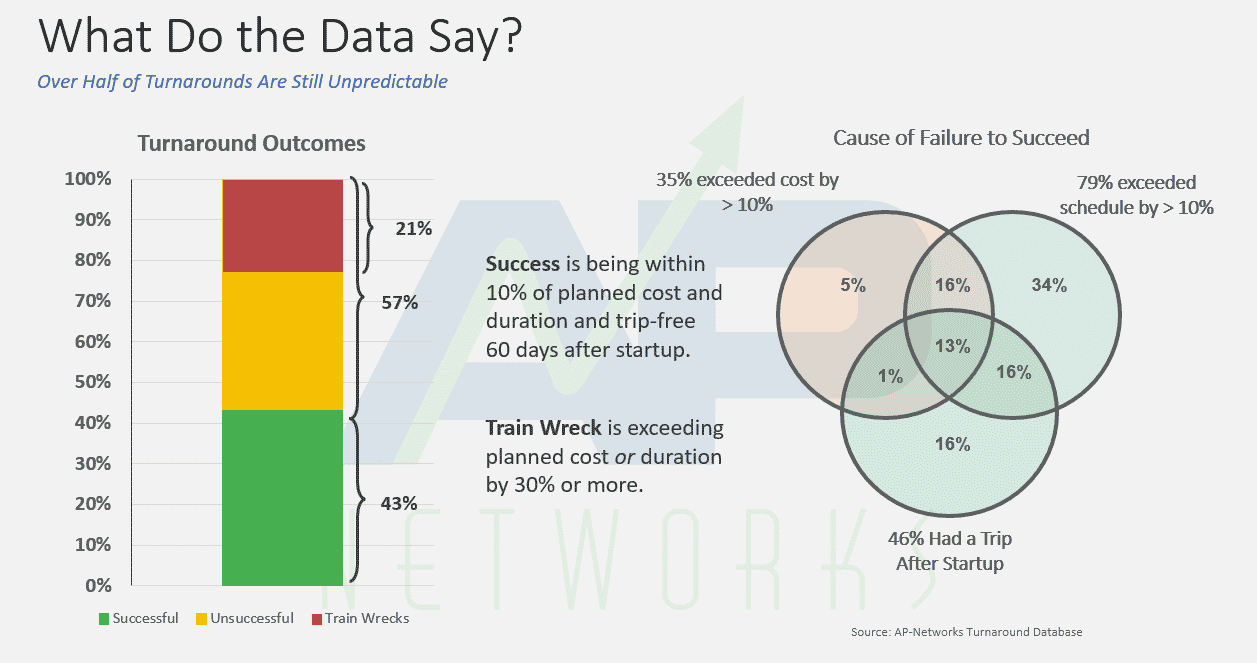The journey toward predictable and competitive shutdown, turnaround and outages (STO)
By Daniel Phan, Regional Manager, Asset Performance Networks, Asia Pacific Pte Ltd
Through the years, and across multiple industries, plant Shutdown, Turnaround and Outages (STO) events are increasing in size and complexity and there is a struggle to keep them within the planned targets. Our data in Figure 1 has shown that in the recent years, significant cost and schedule growth occurs on one in five STO.

The increased availability of event-specific data along with sophisticated data analytic tools have changed the way in which key issues currently affecting these capital-intensive STO events are identified and the practices in use. Our review using the latest analytic tool reveal a set of practices that improve the predictability and competitiveness of plant STO events.
Why do STO events still struggle to achieve their agreed targets?
The Downstream Industry, in general, still does not consistently recognise that STO are unique and complex events that could have significant impact to the bottom line of the organisation. They require more site-wide engagement than day-to-day maintenance, but still need more flexibility than the stage-gated approach from capital projects.
Some of the major contributing factors to cost, schedule and safety deviations observed in Industry are:
- Work process: There is a lack of a “plan-to-plan” approach that rolls back months and even years from the start of the STO event, establishing what, who, when and how to develop the preparation efforts. Without this roadmap, things can be missed or be too late to be implemented to ensure a reliable and safe execution. Even when these processes exist, they tend to be a one-size-fits-all to manage both low (more routine events) and high complexity (events happening once every few years) STO.
- Dedicated organisation: When STO are seen as spot events for the business, the whole mobilisation of resources for the event is normally lost at the end of execution as individuals go back to their regular (not STO) jobs. This strategy makes it more difficult to re-establish the required resourced, in a timely manner, transfer lessons learned, and to manage the long-range planning for the organisation.
- Site-wide events: STO are typically seen as either a “maintenance thing” or a “construction-like project”, with little accountability from the various cross-functional areas such as operations, inspections, procurement, logistics for the outcome. STO require an actively engaged Steering Team, with site-wide participation to enable the STO preparation team to plan and execute the event that is on budget and on schedule.
- Capital projects: As STO and capital projects plan their activities in parallel, there is a high-risk of scope conflict/redundancy, shared resources area congestion, logistic challenges, etc. This creates surprises during execution and inaccuracies and hardship to reconciliate the costs and resource utilisation at the end of the execution phase.
How can we address these issues and achieve better results?
As much as the endgame is to deliver on promises and achieve a performance that is better than the competitors, it all begins by creating a sustainable, stable process to plan and execute plant STO events. It is key to recognise that the development and implementation of a continuous improvement process is a journey, not a destination. To achieve optimal performance, it might take more than one STO cycle, as there is a limited number of significant changes that an organisation can properly manage at once. Recognising these key elements is what has helped multiple organisations, in different Industries, to consistently improve their outcomes.
As shown in Figure 2, the first step of the journey is understanding current organisation maturity defining a baseline for comparison by measuring the historical performance against Industry practices. Safety, cost, and schedule performance metrics, along with data on management approaches and practices help managers understand how these metrics were impacted by the way the STO was planned and executed.

In parallel, a work process may need to be developed or upgraded and implemented. A successful work process defines a list of milestones and deliverables to be developed and includes owners from multiple disciplines. These activities are positioned with sufficient anticipation based on the company’s internal policies, as well as referenced by Industry’s recommended practices. The number of activities should be adequate for the size and complexity of the event and available resources. In most cases, multiple versions of the work process, with more or less detail, need to be built to ensure the best fit.
A well-built work process is only successful when it is consistently followed by proper management and accountability. NaviTrack™, AP-Networks’ proprietary cloud-based solution has been used by multiple sites and industries to ensure that each team member is responsible for their own updates, with transparent information. This behavior drifts away from the typical project manager chasing down people for information and increases the alignment of the whole team. Monitoring the overall progress (what was completed from the due activities) and compliance (what was completed at the agreed time) is paramount to minimise the risk and ensure that every department understands the impact of their work in the larger preparation effort.
Stemming from the issues identified from the management of the work process, as well as a risk management process needs to be implemented. There are multiple tools available in the market, but the key success factor is still the same: time for planning, the consistent management of the plan, with identified actions, owners, and due dates for all the risks identified. The adequate monitoring of risk resolution, with visibility at the Steering Team level, will ensure any gaps are addressed in a timely manner.
The path to sustainable results leads to increased competitiveness
With these practices and routines implemented and effectively running, the path to STO management excellence leads to the establishment of an assurance review program. Unlike capital projects stage-gate reviews, the assurance review program consists of milestones in the continuous STO preparation that don’t withhold the advancement to the next phases but offer recommendations to address the gaps and risks at that particular point in time. These reviews help the team meet cost and schedule targets and improve execution efficiency.
AP-Networks has been working for the past 20 years with industrial facilities – in multiple sizes, continents, and industries – providing independent readiness and closeout reviews across the different preparation stages. These observations and recommendations, once implemented, have been leading these organisations to significant improvement in their STO outcomes. The reviews are supported by our unparalleled database of STO-focus metrics and benchmarks, supporting the recommendations with proven data-driven support that enable the refinement and validation of estimates and outcomes.
Knowing that several organisations still face significant overruns (1 in 5 STO have overruns in cost and schedule of 30% or more), engaging the journey to implement and sustain these practices will enable your organisation to top performance STO results.
_____________________________________________________________________________________________

Daniel Phan is currently a Regional Manager with Asset Performance Networks Asia Pacific (AP-Networks) in Singapore. He has more than 20 years of experience in plant STO and project management consultancy in the oil & gas, petrochemical, maritime industries.
AP-Networks is the trusted leader for improving asset and operational performance in petroleum, chemical, mining, agricultural and other manufacturing companies worldwide. AP-Networks works with the client’s most critical assets—their people, processes, and production facilities—in order to help them achieve safe, competitive, predictable outcomes on their high-risk events—namely capital projects and STO.
Contact: dphan@ap-networks.com